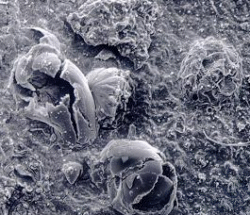Metallurgical Technologies, Inc.
Corrosion Engineering and Metal Corrosion Testing Services

Corrosion is a phenomenon leading to exorbitant losses of materials, energy, and money by causing degradation of products, materials of construction, equipment, and necessitating increased maintenance. This leads to unplanned shutdowns and may even result in serious accidents.
MTi specializes in corrosion investigations and analytical techniques used to identify corrosion mechanisms. We have the expertise to recommend more corrosion resistant alloys for a particular application or environment to prevent recurrent corrosion issues. Our Energy Dispersive x-ray Spectrographic system (EDS) is capable of analyzing corrosion deposits to identify the corrosive agent. MTi can also provide corrosion testing to determine the suitability of materials for specific conditions.
Corrosion Engineering and Metal Corrosion Testing Services - Example 1:

Carbon steel pipe fittings from a fire suppression system corroded due to micro-biologically influenced corrosion (MIC), most likely due to anaerobic sulfate reducing bacteria. Structures that appear to be tubercles (i.e. hollow mounds of corrosion product and deposits that cap localized regions of metal loss) form due to oxygen concentration cells. The oxygen gradient inside tubercles can lead to the formation of anaerobic conditions and colonization by sulfate reducing bacteria. Tubercles generally have shallow dish shaped depressions caused by corrosion of the base metal. However, when sulfate reducing bacteria are present, deep discrete hemispherical pits form. (Scanning Electron Microscope (SEM) Photo, Mag: 100X)
Corrosion Engineering and Metal Corrosion Testing Services - Example 2: 
A high magnification Scanning Electron Microscope image of crevice corrosion at the location of a Teflon washer on a 316L stainless steel plate. Severe attack is clearly visible and the original machining marks, once visible, are no longer observed. (Scanning Electron Microscope (SEM) photo Mag: 15X)
Corrosion Engineering and Metal Corrosion Testing Services - Example 3: 
A SEM/BSE image of a corrosion pit associated with stress corrosion cracking in a stainless steel drum. The Back Scatter Electron (BSE) imaging mode of the Scanning Electron Microscope is sensitive to compositional variations. The corrosion products appear dark with the stainless steel base metal appearing white. SEM/EDS analysis indicated a high concentration of chlorine in the corrosion deposit. (Scanning Electron Microscope (SEM) photo, Mag: 100X)
Click here for more Product Details from
Metallurgical Technologies, Inc....